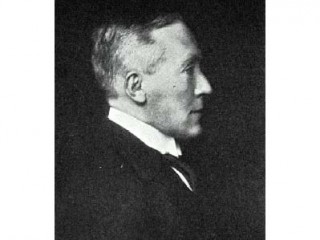
Frederick Donnan biography
Date of birth : 1870-09-06
Date of death : 1956-12-16
Birthplace : Colombo, Ceylon
Nationality : Irish
Category : Science and Technology
Last modified : 2010-05-19
Credited as : Physical chemist, Donnan equilibrium,
0 votes so far
Frederick George Donnan was an Irish chemist whose work was instrumental in the development of colloid chemistry. In electrochemistry, he studied (1911) the electrical potential set up at a semipermeable membrane between two electrolytes, an effect of importance in living cells, known as the Donnan Equilibrium: If diffusible solutes are separated by a membrane that is freely permeable to water and electrolytes but totally impermeable to one species of ion, the diffusible solutes become unequally distributed between the two compartments.
Donnan, who was blind in one eye is depicted in profile Frederick George Donnan was born in Colombo, Ceylon (now Sri Lanka), of Northern Ireland parents (father: William Donnan and mother: Jane Ross Turnley Liggate). He returned to Ireland with the family at the age of 3.
Donnan was educated at Queen’s College in Belfast, N. Ireland, from 1889 to 1893 (BA in 1892) and in 1894 he received MA from the Royal University of Ireland. Frederick G. Donnan continued his education at the Universities of Leipzig, Berlin, and London.
In Germany he worked until 1897 with Wislicenus, van’t Hoff and Ostwald, and thus helped introduce the ‘new’ physical chemistry into Britain. From 1898 to 1903 he worked in Professor (later Sir William) Ramsay’s laboratory in University College London. In 1903 he became a Lecturer in Organic Chemistry at the Royal College of Science in Dublin. The following year he was appointed Professor of Physical Chemistry in Liverpool. He supervised the building of the Muspratt Laboratory of physical chemistry and was its Director from 1906 to 1913.
In 1913 Donnan succeeded Ramsay as Professor of General Chemistry at University College London, where he remained until his retirement in 1937. From 1924 to 1926 he served on the Council of the Royal Society and was President of the Faraday Society.
He was also a member of the Advisory Council of the Department of Scientific and Industrial Research from 1925 to 1930; and from 1925 to 1933 he was Foreign Secretary of the Chemical Society. In 1928 he received the Davy Medal of the Royal Society for his contributions to physical chemistry and particularly for his theory of membrane equilibrium. In 1936 he became a Fellow of University College London. He was President of the Chemical Society from 1937 to 1939, and Chairman of the Royal Society Scientific Relief Committee from 1941 to 1946.
Before WWII Donnan helped Jewish scholars emigrate from Germany and Austria, amongst whom were Jahn and Teller who produced their ‘Jahn and Teller’ effect while working in London. During the war he was involved in the industrial production of ’synthetic’ ammonia and nitric acid. Donnan’s major contribution was the theory of membrane equilibrium. This had important applications in colloid chemistry, and above all, in the understanding of the living cell. He wrote no book but was author of more than a hundred papers.
In 1911 Donnan studied the conditions under which equilibrium is established between two electrolytic solutions separated by a semipermeable membrane–that is, by a membrane through which the solvent and some, but not all, of the dissolved ions can pass. In the absence of such a membrane, the solvent and every species of dissolved ion will diffuse freely from each solution into the other, until the composition of the two solutions becomes the same.
The semipermeable membrane, however, prevents the transfer of at least one ionic species, and the preservation of electrical neutrality limits the diffusion of that species’ oppositely charged partner. Nevertheless, some movement of mobile ions does occur, and the compositions of the solutions change; as a result, the final distribution of the ionic species is unequal, and there is a measurable difference in the electric potential of the solutions on each side of the membrane. The nature of the equilibrium and the existence of the potential have both become associated with Donnan’s name.
The equilibrium characterized by an unequal distribution of diffusible ions between two ionic solutions (one or both of the solutions may be gelled) separated by a membrane which is impermeable to at least one of the ionic species present, e.g. because they are too large to pass through the pores of the membrane. The membrane may be replaced by other kinds of restraint, such as gelation, the field of gravity, etc., which prevent some ionic components from moving from one phase to the other, but allow other components to do so.
Frederick G. Donnan was the first to elucidate the effect of semi-permeable membranes on ionic equilibria and osmotic pressure, but he also studied colloids and soap solutions, showing that the efficiency of hydroxyl ions in the emulsification of oils depended on the formation of soaps on the surface of the drops; studied the effects of the sodium salts of the straight chain acids on the oil-water interface; studied the rates of effusion of some of the rare gases, the surface energies and densities of a number of liquified gases, the rates of reaction of the alkyl iodides with silver nitrate, the solubility of oxygen in silver, and the colors of the salts of cobalt, iron, and copper from the standpoint of electroaffinity; investigated manufacture of synthetic ammonia and nitric acid.
Frederick G. Donnan died on December 16, 1956, in Canterbury, Kent, England.
















